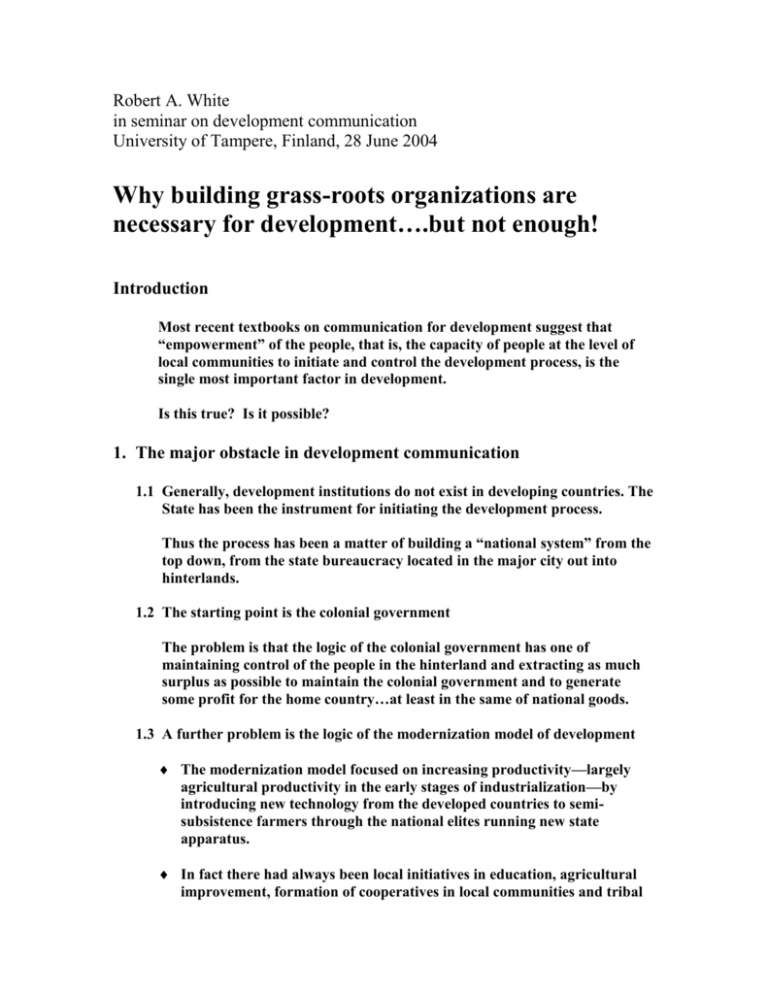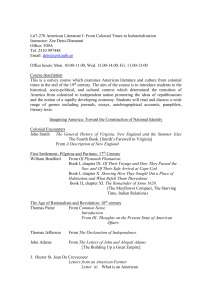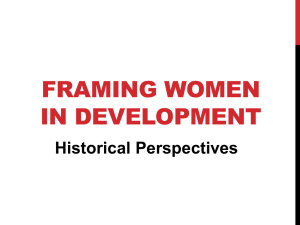Why building grass-roots organizations is necessary for
advertisement

Robert A. White in seminar on development communication University of Tampere, Finland, 28 June 2004 Why building grass-roots organizations are necessary for development….but not enough! Introduction Most recent textbooks on communication for development suggest that “empowerment” of the people, that is, the capacity of people at the level of local communities to initiate and control the development process, is the single most important factor in development. Is this true? Is it possible? 1. The major obstacle in development communication 1.1 Generally, development institutions do not exist in developing countries. The State has been the instrument for initiating the development process. Thus the process has been a matter of building a “national system” from the top down, from the state bureaucracy located in the major city out into hinterlands. 1.2 The starting point is the colonial government The problem is that the logic of the colonial government has one of maintaining control of the people in the hinterland and extracting as much surplus as possible to maintain the colonial government and to generate some profit for the home country…at least in the same of national goods. 1.3 A further problem is the logic of the modernization model of development The modernization model focused on increasing productivity—largely agricultural productivity in the early stages of industrialization—by introducing new technology from the developed countries to semisubsistence farmers through the national elites running new state apparatus. In fact there had always been local initiatives in education, agricultural improvement, formation of cooperatives in local communities and tribal 2 groups in the colonial period. The colonial government had tended to discourage this. The new development elites controlling the newly formed governments continued this policy of ignoring or discouraging independent local initiatives. The logic of modernization was that rural people were “traditional” and that traditional technology had little to contribute to improving productivity. Increased productivity was to come through the introduction of “packages” of new technology wholly introduced from the outside as part of campaigns to meet national productivity goals set in national planning offices of the new governments. Production goals were set without consultation of farmers and farmers were expected to simply to “comply” with the guidelines of inexperienced and badly trained extension agents. Finally, the native colonial elites prepared to take over the colonial governments identified with the culture of the expatriate colonial governing personnel. Just as expatriates looked outside to the mother country, so also the colonial elites defined their role as occupying positions of power, economic privilege, cultural supremacy and identification with an expatriate culture. The elites running the new governments knew little of the people of the interior and were more interested in their personal benefits than actually helping the people of the interior to develop. The argument of Nyamjoh that the state in African countries is a parasitical institution is true, but one must add that the reason is that the governing social class is dominated by a parasitical culture inherited from the colonial period. National budgets are directed mostly to services in the national capital, not to services in the rural areas. 1.4 The dilemma of development On the one hand, the state in Africa (and elsewhere) has not and will not, as it is presently constituted, provide the services for national development. On the other hand, empowerment—development of grassroots organizations of the people—cannot develop without the support structure of the state. 3 2. The “empowerment” strategy of development 2.1 What is it essentially? An organization of people at the local community level which enables them to: Elect their own leadership Analyse their own problems and decide on the priority actions Design the activity they are going to carry out Outside technical advice responds and supports local decisions Be the administrative channel of the resources from the outside (credit, technical inputs, marketing procedures, etc.) Many programs of national and international development assistance now operate with this approach of first helping people to decide what they want to do and then form their own local organizations. 2.2 These local organizations are then “networked” at the district or regional level and development assistance agencies deal with the local groups largely through the district organization. The longer-term goal is this district or regional organization become a people-based NGO which is permanently in charge of their development assistance. Such an NGO would hire their own technical personnel and deal directly with government or international agencies. 2.3 This process of empowerment presupposes: A new type facilitative technical assistance agent A strong development training programme for the leadership in this process A strong development communication education process through radio or a multimedia process (radio + print media + interpersonal contact + group media, etc.) 2.4 It is presupposed that the people-based NGO which emerges will also be a political pressure group representing needs to the government. 2.5 The NGO may also develop into a regional/national marketing and technical assistance organization with their own hired managers. 4 3. People’s media such as community radio are an important part of this empowerment strategy 3.1 In the local language or dialect 3.2 Run by local volunteers to reduce costs 3.3 With programmes locally produced to take advantage of local knowledge 3.4 Encouraging a dialogical interchange of information 3.5 Taking up power relations issues in local communities 3.6 Preserving and encouraging local pride and local culture 3.7 Promoting a culture hope and confidence in the local people 3.8 Representing the local communities or districts in disputes with government or representing local interests in national level projects 4. Where does the motivation to form local organizations come from? This mobilization requires: Motivation Enormous courage, sacrifice of time and risk Redefinition of identity to a people who can solve their own problems Redefinition of the relation with the government and with other institutions 4.1 Motivation comes partly from the long-standing desire of local people to run their own affairs. 4.2 From the frustration with the non-response from government agencies 4.3 From the frustration with oppression (taxes, economic exploitation, the political exploitation from parties that seek support and cause conflict but never deliver anything, etc.) 4.4 The desire to have the independence of their own leadership and cut loose from the humiliating dependency on a clientelistic structure. 5 4.5 Some motivation come from alliances with groups and institutions that can help, provide organizational support, etc. The churches can be important…these are a religious people. Gender (women) and age (youth) movements Political economic movements 5. But grassroots organizations can’t work without government support 5.1 The agreement to not repress independent organization with police action 5.2 Provide economic resources: credit, etc. 5.3 Provide marketing opportunities 5.4 Provide favourable legislation 5.5 Permissions for community radio, etc. 6. The real problem is dealing with the “parasitical culture” of a parasitical social class 6.1 Urban-technical services are interested only as long as people’s organizations are an instrument for their own path to power. 6.2 The inconstancies of the alliances Urban-technical elites move on to other jobs and other interests that are lucrative… 6.3 The leaders of peoples organizations lose interest in their people Once they become part of the managerial class. 6.4 Once people’s organization gain power, they forget about other organizations struggling to get started. 6 7. What is the answer? 7.1 A culture of service in government and in parastatal organizations 7.2 The development of the civil society to promote and enforce responsibility on the part of government 7.3 A process of “cultural negotiation” in decision making which brings all social groups, including rural organizations, into government decisionmaking and government councils 7.4 Seeking symbols of universal human rights and universal service as the basis for national development culture This would replace the self-seeking culture of empowerment Would replace the culture of clientelistic dependency which now exists









